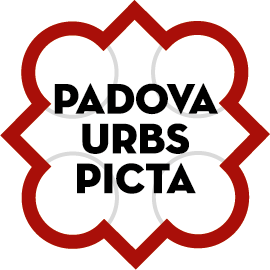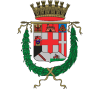The cartwheel that figures on the Padua Portal may look like a logo inspired by Optical Art but it is actually a historical reference: to the wheels of the carro [cart] that figures in the coat-of-arms of the Carraresi family, who ruled Padua from 1318 to 1405 (when the city was conquered by the Venetian Republic). The most famous members of that dynasty were Ubertino, Giacomo, Francesco ‘Il Vecchio’ and Francesco Novello, and there are still extant traces within the city of their period of rule.
The Carraresi palace was a sprawling complex of buildings of which you can now see the magnificent Loggia, close to Piazza Capitaniato, where there is also the wonderful Sala dei Giganti (restored in the sixteenth century). The palace was obviously a centre of political and military power, and in its day it was linked to the fortifications of the Castle and the Specola Tower by a raised walkway that stood nine metres high and was three metres wide (the few extant traces of this are in the street alongside the Loggia). Usually only part of these extant remains of the palace are open to the public, but they are a reminder of the troubled century when the Carraresi ruled the city. The first Carraresi ruler of Padua was actually Litolfo da Carrara (in 1027), but the dynasty would then return to rule throughout nearly the whole of the fourteenth and the first few years of the fifteenth century. At the height of their glory, the dynasty also ruled Verona, Vicenza, Treviso, Feltre, Belluno, Udine and Aquileia.
The aristocratic family of Papafava dei Carraresi got its name in a rather unusual manner. Around one thousand years ago, the Bishop of Chioggia was in the habit of giving broad beans once a week to a rather frail child who was very fond of them. When doing so, he used to say, in Veneto dialect : “papa fava” [eat the beans]. The boy’s friends were regular witnesses of the scene and gave him the nickname ‘Papafava’, which was the origin of the surname that continued unchanged over the centuries. It is the modern descendants of that family who still recount the episode.












